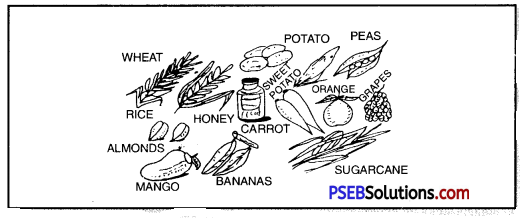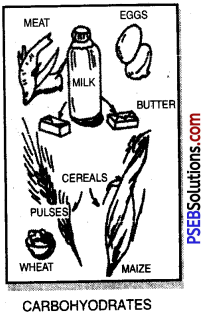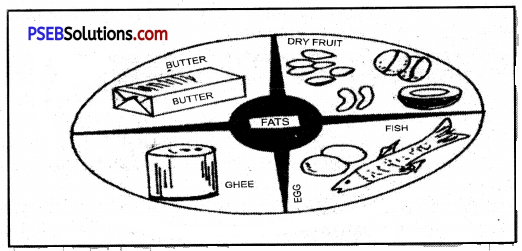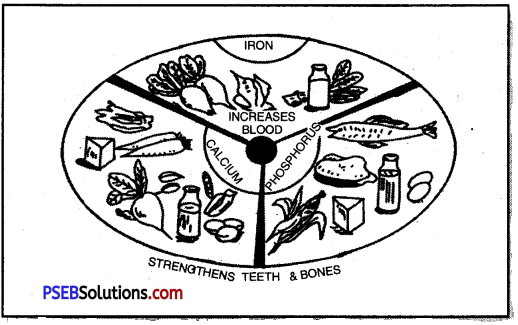Punjab State Board PSEB 8th Class Physical Education Book Solutions Chapter 2 Nutritious and Balanced Diet Textbook Exercise Questions and Answers.
PSEB Solutions for Class 8 Physical Education Chapter 2 Nutritious and Balanced Diet
Physical Education Guide for Class 8 PSEB Nutritious and Balanced Diet Textbook Questions and Answers
Question 1.
What do you mean by food?
Answer:
Food is very important for our body because it helps in the growth and development of our body. It repairs old cells and forms the new cells. Food prevents us from diseases. We consider such things as food which becomes part of our body after taking it and develops the body.
![]()
Question 2.
What do you mean by nutritious food?
Answer:
The following are the constituents of nutritious food:
- Proteins
- Vitamins
- Carbohydrates
- Fats
- Mineral Salts
- Water.
Question 3.
What do you mean by balanced diet?
Answer:
Balanced Diet. Balanced diet is the diet which has all the nutrients in right proportion and which is capable of fulfilling all the needs of the body. It should have all nutrients like carbohydrates, proteins, fats, vitamins, minerals, salts and water in proper proportion. Such a diet needs to be taken for the proper development of body, protection from diseases and good health. No single item of food is balanced diet in itself. Only milk is an exception, as it has got almost all nutrients.
Question 4.
What do you understand by protein? How many types of proteins are there?
Answer:
Proteins:
Protein is a complex compound consisting of carbon, hydrogen, oxygen, sulphur, phosphorus and nitrogen. It is of two kinds vegetable protein and animal protein.
Sources:
1. Vegetable Protein: It is available in soyabeans, groundnuts, cashew-nuts, pistachio, walnuts, wheat, millet, maize, etc.
2. Animal Protein: It is available in meat, fish, egg, cheese, etc.

Advantages of Protein:
- It ensures physical growth and development
- It repairs broken tissues
- It keeps the body temperature normal
- It produces energy in case there is lack-of the quantity of carbohydrates or fats in the body.
Harms due to lack of Proteins:
The body catches the following diseases due to lack of proteins-
1. Kwashiorkor:
This disease is common in children in the age group of 1-3 years in case there is lack of proteins. At first, the child’s legs are affected. Then this disease causes swelling on the face and then the whole body. The skin of the child becomes rough and red. The child becomes irritated.
2. Rickets or Rachitis:
As a result of the lack of proteins children suffer from rachitis. A child affected with this disease looks very thin and weak. Bones are visible through his flesh.
3. Hunger Oedema:
Because of prolonged hunger and lack of protein, the body does not get nourishment, and water gets accumulated in cells, and body appears to be swelled up.
4. Pellagra: As a result of this disease, one’s skin appears to be rough and dry.
5. Defect in the Liver. Liver gets damaged due to the lack of protein in food.
Harms due to excess of Proteins:
One may suffer from kidney ailments in case of excessive intake of proteins. Blood vessels too get affected and one begins to have joint pains.
Proper quantity:
Children in the age group of 1-6 years are in dire need of proteins in large amount. A normal person should consume 70 to 100 gms. of proteins every day.
![]()
Question 5.
What are carbohydrates? What are the harmful effects of its deficiency and excess.
Answer:
Carbohydrates: Carbohydrates provide heat and energy to the body. Indians, in general, compensate 70-80% of their food with this element.
Sources: Carbohydrates are available in wheat, rice, barley, maize, millet, jaggery, sugar, potatoes, etc.
Advantages of Carbohydrates:
- Carbohydrates provide heat and energy to the body.
- They help in digesting fat.
- They cleanse intestines and liver.
Harms due to lack of Carbohydrates:
- As a result of the lack of carbohydrates, blood loses its alkaline nature, and becomes more acidic. In such a condition, a person may become unconscious. In such a condition due to hunger one may get diabetes.
- Intestines are not cleaned properly.
- As a result of lack of carbohydrates, fats remain undigested in the body.
- As a result of lack of carbohydrates acidic elements in the liver get cleansed, and it is harmful to the body
- A person becomes very weak and may die in case there is excess of lack of carbohydrates in his food.

Harms due to excess of Carbohydrates:
The excess of carbohydrates causes-
- fatness
- high blood pressure
- joint pains and
- diabetes.
Proper Quantity:
Our food has 50-80% of carbohydrates. 50-60% part of balanced diet consists of carbohydrates. A normal person should have 400 to 700 gms. of carbohydrates in his daily food.
![]()
Question 6.
What do you mean by fats? What are its types.
Answer:
Fats are of two types-
(i) vegetable fats
(ii) animal fats.
Sources.
1. Vegetable Fats. These are available in almonds, walnuts, soyabeans, groundnuts, coconut oil, mustard, etc.
2. Animal Fats. These are available in ghee, butter, milk, meat, fish, egg, etc.

Advantages:
- It provides energy to the body.
- It keeps the body temperature stable.
- It protects all parts of the body against external injuries.
- It keeps in reserve vitamins A, D and K according to the needs of the body.
Harms due to the lack of Fats:
The body suffers in the following ways in case there is lack of fats-
- Skin becomes dry.
- The deficiency of vitamins A, D and K follows.
- The skin goes dry because of the lack of acids of fat.
Harms due to excess of Fats:
The excess of fats in one’s food also proves to be harmful in the following ways-
- One suffers from obesity.
- Heart diseases are caused.
- Digestion weakens.
- One suffers from diabetes.
- Stones may form in the abdomen.
Proper Quantity: A normal person should have 50 to 75 gms. of fats in his daily food.
![]()
Question 7.
Milk is a complete food. Explain it?
Answer:
Milk:
Milk is an ideal and whole food. It has got all the essential nutrients. It has 3.6% fat, 3.4% protein, 4.8% carbohydrates, 0.7% salts and 7.5% water. Milk is given to growing children because it is a complete food. At home, patient is also given milk which acts as complete food.
For good health, milk serves as a balanced diet.
All the essential nutrients as proteins, carbohydrates, fats, minerals, salts, water, vitamins are available in milk in right proportion. All these nutrients have different functions to perform in our body. Milk is considered to be an ideal food as it has all the essential nutrients including vitamins, though it does not have iron.
Question 8.
What are the principles of cooking food?
Answer:
Cooking Food:
Properly cooked food is useful for health. Food must be cooked properly, if food is over cooked, it does loses some essential nutrients like vitamins C and D. Food must be cooked properly for the following reasons:
- Properly cooked food becomes easily digestible.
- By cooking food disease causing germs get killed.
- Cooked food is tasty. One feels like eating it.
- We can preserve the cooked food for long.
Methods of Cooking food:
The following methods for cooking food are generally followed-
- Boiling
- Cooking with steam
- Roasting
- Frying
These methods are explained in brief below:
1. Boiling:
In this method, food articles are cooked by boiling in water. But essential vitamins and mineral salts dissolve in water and are lost in this method of cooking. A little quantity of water should be used in boiling eatables. If water used in boiling is excessive, it should not be thrown. Rice, pulses, meat and vegetables are cooked by boiling.
2. Cooking with Steam:
Food is also cooked with steam. Essential nutrients do not get lost in cooking by this method. The food cooked in a steam cooker is nutritious and beneficial to health. So this method is considered to be better than other methods.
3. Roasting:
In this method, food is directly roasted on the fire. Excessive roasting also destroys essential nutrients. The roasted meat is tasty and easily digestible.
4. Frying:
There are many food items such as ‘pakora’, ‘samosa’ and “purian” which are fried. Food is cooked very soon by frying. But essential nutrients also get lost in this method. Moreover, fried food is not easily digestible, and is often harmful to one’s health. Best Method. Of all the methods of cooking, cooking with steam is the best. The food cooked in this way does not lose essential nutrients and it is very beneficial to one’s health.
![]()
Question 9.
Explain the rules of taking food.
Answer:
- Always have your food at a fixed time. Untimely eaten food causes indigestion.
- Wash your hands with soap before taking meals and always wear clean clothes. Nails should be cut and cleaned.
- We should not eat too hot or too cold food. Hot food causes blisters or boils and cold food cannot be chewed properly.
- Food should be taken in an adequate quantity, over-eating may cause indigestion.
- Food should be chewed slowly and properly so that it can be digested easily.
- Food should be nutritious and easily digestible.
- Never take stale food because it causes food poisoning.
- We should be happy while taking food. Never talk or watch T.V. while taking food.
- Take dinner at least two hours before sleeping because it is dangerous to sleep immediately after taking a meal.
- Rest a while after meals.
Question 10.
Right notes on the following:
(a) Roughage
(b) Water
(c) Minerals
(d) Cooking food.
Answer:
(a) Roughage:
Wheat, pulses, vegetables, fruits, dry fruits, milk, meat, fish are the main food products. The advantages of these are as under:
(i) Cereals:
Wheat, rice, grams, maize, barley are generally taken as food.
Advantages of Cereals:
- These are helpful for the formation of our body.
- Food provides energy to body.
- They contain too much carbohydrates.
- The outer parts of these food material provide iron, lime, vitamins and proteins.
- They are very useful to remove constipation.
(ii) Pulses:
Soyabean, peas, turnip, almonds are counted in pulses. These pulses provide us vitamins A, B, and C. They also supply us with proteins, minerals, salt, iron and phosphorus.
Advantages of Pulses:
- These provide energy.
- Increase appetite.
- Improve digestion.
(iii) Vegetables:
Cauliflower, palak, sarson ka saag, methi, carrots, walnut, turnip, tomatoes, potatoes, peas, cabbage and onion are the main vegetables.
Advantages of Vegetables:
- Vegetables protect our body.
- Vegetables maintain the health of a person.
- They purify the blood.
- They prevent constipation.
(b) Water:
Our body is composed of 2/3rd of water. It is formed of the combination of oxygen and hydrogen. It is as important as air for our body.
Sources. It is available in pure form in many nutrients also such as milk, fruit and vegetables.
Uses of Water:
- Water helps in the formation of cells.
- It carries nourishment to cells. It helps in the excretion of waste products from the body.
- It helps in digestion of food.
- It regulates the heat in our body.
- It helps in mixing nutrients with blood.
- It keeps the parts and joints of body soft.
- It ensures blood circulation in the body.
Harms due to lack of Water:
There are many harms of drinking less water-
- The food does not digest properly in case one drinks less water.
- Liver remains heavy.
- Constipation is caused.
- One feels physical fatigue all the time.
- The body gets weakened.
- The face turns pale.
- Waste products in the body do not get excreted properly.
- One is afflicted with joint pains.
- Stones are formed in kidneys.
Harms due to excess of Water:
Water should always be taken in right proportion. Liver remains filled by taking water in excess and one does not feel appetite. If one continues taking water with food, food does not digest properly.
Proper Quantity:
The quantity of water intake varies with season, exercise and food. Normally, 5-6 glasses of water a day are enough for a normal person.
(c) Minerals:
Our body has 4% of minerals and salts. Phosphorus, calcium, sodium, chlorine, potassium, magnesium, manganese, iodine and zinc are some prominent minerals.

Sources:
Minerals and salts are available in green vegetables, fruits, meat, milk. Milk has less amount of iron, but it has all other minerals.
Advantages of Minerals:
1. They help in the development of muscular tissues.
2. They make the blood red.
3. Calcium helps in blood clotting.
4. Iron is very important for the formation of blood.
5. Minerals help in the Topper functioning of all parts of the body.
Harms due to lack of Minerals:
- The lack of calcium causes the weakening of teeth and bones.
- Body loses its power of resistance to diseases.
- The lack of iodine is the cause of goitre in the body.
(d) Cooking Food:
Properly cooked food is useful for health. Food must be cooked properly, if food is over cooked, it does loses some essential nutrients like vitamins C and D. Food must be cooked properly for the following reasons:
- Properly cooked food becomes easily digestible.
- By cooking food disease causing germs get killed.
- Cooked food is tasty. One feels like eating it.
- We can preserve the cooked food for long.
Methods of Cooking food:
The following methods for cooking food are generally followed-
1. Boiling
2. Cooking with steam
3. Roasting
4. Frying
These methods are explained in brief below:
1. Boiling:
In this method, food articles are cooked by boiling in water. But essential vitamins and mineral salts dissolve in water and are lost in this method of cooking. A little quantity of water should be used in boiling eatables. If water used in boiling is excessive, it should not be thrown. Rice, pulses, meat and vegetables are cooked by boiling.
2. Cooking with Steam:
Food is also cooked with steam. Essential nutrients do not get lost in cooking by this method. The food cooked in a steam cooker is nutritious and beneficial to health. So this method is considered to be better than other methods.
3. Roasting:
In this method, food is directly roasted on the fire. Excessive roasting also destroys essential nutrients. The roasted meat is tasty and easily digestible.
4. Frying:
There are many food items such as ‘pakora’, ‘samosa’ and “purian” which are fried. Food is cooked very soon by frying. But essential nutrients also get lost in this method. Moreover, fried food is not easily digestible, and is often harmful to one’s health. Best Method. Of all the methods of cooking, cooking with steam is the best. The food cooked in this way does not lose essential nutrients and it is very beneficial to one’s health.
![]()
PSEB 8th Class Physical Education Guide Nutritious and Balanced Diet Important Questions and Answers
Multiple Choice Questions
Question 1.
Balanced diet contains:
(A) Protein
(B) Carbohydrates
(C) Fats and Mineral Salts
(D) Above all.
Answers:
(D) Above all.
Question 2.
How the protein is made?
(A) Carbon
(B) Oxygen
(C) Hydrogen
(D) None of them.
Answers:
(A) Carbon
(B) Oxygen
(C) Hydrogen
Question 3.
How many types of Protein?
(A) Two
(B) Three
(C) Four
(D) Five.
Answers:
(A) Two
Question 4
Write the sources of Fat:
(A) Fruits .
(B) Soyabeans
(C) Groundnuts
(D) All above.
Answers:
(A) Fruits .
(B) Soyabeans
(C) Groundnuts
![]()
Question 5.
Mention the types of carbohydrates
(A) Two
(B) Three
(C) Four
(D) Five.
Answers:
(A) Two
Question 6.
Important food is:
(A) Butter
(B) Fruits
(C) Almond or Milk
(D) None of these.
Answers:
(C) Almond or Milk
Question 7.
The rules of eating food:
(A) Always have your food at fix time.
(B) Wash your hands with soap before taking meal.
(C) Food should be chewed slowly.
(D) All above.
Answer:
(A) Always have your food at fix time.
(B) Wash your hands with soap before taking meal.
(C) Food should be chewed slowly.
(D) All above.
![]()
Very Short Answer Type Questions
Question 1.
What is the meaning of food?
Answer:
Those eatable things which satisfy our hunger and develop our body are called food.
Question 2.
Write down the salts, which are found in our food?
Answer:
Calcium, phosphorus, iron, sodium, magnesium, potassium, iodine, chlorine, and sulphur are salts found in our body.
Question 3.
Why the food cooked on steam is considered well?
Answer:
Because the food cooked by steam does not destroy the nutritious elements.
![]()
Question 4.
What is the percentage of water in our body?
Answer:
There is 60% of water in the body of a human being.
Question 5.
How many types of proteins are there? Write their names.
Answer:
Proteins are of two types:
- Animal proteins
- Vegetable proteins.
Question 6.
Mention sources of Animal Proteins
Answer:
It is available in meat, fish and milk.
Question 7.
Mention the three sources of Vegetable Proteins.
Answer:
It is available in soyabeans, groundnuts and cashew-nuts.
![]()
Question 8.
What are Carbohydrates?
Answer:
Carbohydrates contain Carbon, Hydrogen and Oxygen.
Question 9.
Mention the types of vitamins.
Answer:
Vitamins are of six types-A, B, C, D, E and K.
Question 10.
Lack of which vitamin causes night blindness?
Answer:
Lack of Vitamin A.
Question 11.
Lack of which vitamin causes Berry-Berry disease?
Answer:
Lack of Vitamin B.
Question 12.
Lack of which vitamin causes Scurvy disease?
Answer:
Lack of Vitamin B.
![]()
Question 13.
What is the cause of Pyoria?
Answer:
Lack of Vitamin C.
Question 14.
Lack of which vitamin causes infertility in women?
Answer:
Lack of Vitamin E.
Question 15.
Mention the vitamins which are not soluble in water?
Answer:
Vitamins C, D and K.
Question 16.
Which milk is useful for a child?
Answer:
Mother feed.
Question 17.
What are the various methods of cooking food? Name them.
Answer:
- Boiling
- Roasting
- Frying
- Cooking with steam.
![]()
Question 18.
How much quantity of proteins should we take in our daily meals?
Answer:
70 to 100 grams.
Question 19.
Describe the main constituents of carbohydrates.
Answer:
Starch and sugar.
Question 20.
Name the constituents of proteins.
Answer:
Carbon, Nitrogen, Hydrogen and Sulphur.
Question 21.
To whom do we call life giving?
Answer:
Vitamins.
Question 22.
Which vitamins are soluble?
Answer:
Vitamins B and C.
Question 23.
How much Fat do we require in our meals?
Answer:
50 to 70 gms.
![]()
Question 24.
Which disease is caused by lack of iron?
Answer:
Lack of Haemoglobin.
Question 25.
What should be kind of Dinning site?
Answer:
Clean and airy.
Short Answer Type Questions
Question 1.
What is the meaning of food?
Answer:
Food is very important for our body because it helps in growth and development of our body. It repairs olcfcells and forms the new cells.
Food prevents us from diseases. We consider such thing as food which becomes part of our body after taking it and develops the body.
Question 2.
Why it is necessary for our body?
Answer:
Everybody needs food for living. Daily we take part in many activities or perform so many types of work. To perform these activities we need energy. This energy is derived from food.
Question 3.
What are the advantages of food?
Answer:
- Food provides energy to the body.
- Food helps growth and development of the body.
- Food helps in the formation of new cells.
- Food helps in repairing the broken cells.
- Food helps in preventing diseases.
![]()
Question 4.
Name the main nutrients of food.
Answer:
The following are the constituents of food:
- Proteins
- Vitamins
- Carbohydrates
- Fats
- Mineral Salts
- Water.
Question 5.
How is water useful for our body?
Answer:
Our body needs water to live. We cannot live without water. Advantages of Water.
- It carries nourishment to cells. It helps in the excretion of waste products from the body.
- It regulates the heat in our body.
- It helps digestion of food.
- It helps in mixing nutrients with blood.
- It keeps the parts and joints of the body soft.
- It ensures blood circulation in the body.
![]()
Question 6.
Why it is compulsory to cook food?
Answer:
Need for cooking food. Properly cooked food is useful for health. Food must he cooked properly. If food is overcooked, it loses some essential nutrients like vitamins C and D. Food should be cooked for the following reasons:
- Properly cooked food becomes easily digestible.
- By cooking food disease-causing germs get killed.
- Cooked food is tasty, one feels like eating it.
- We can preserve the cooked food for long.